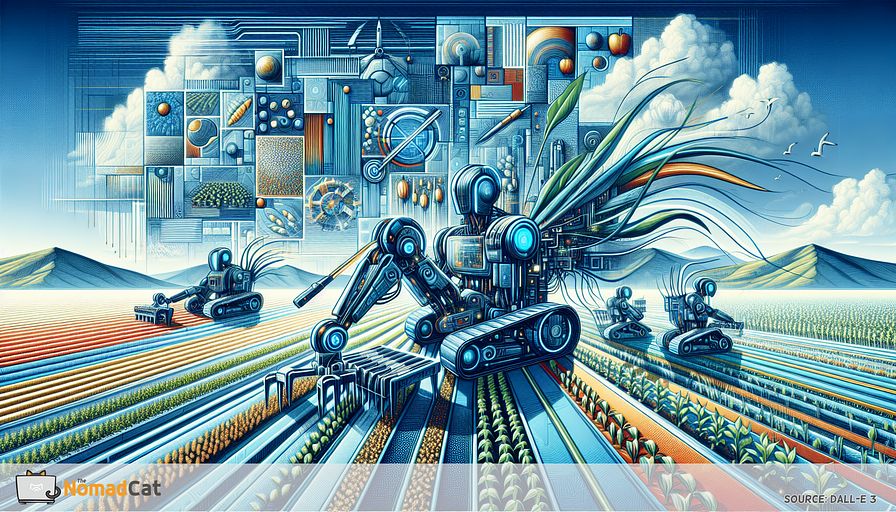Abstract:
Agricultural robotics, or AgriRobots, are at the forefront of revolutionizing traditional farming practices. These advanced machines are designed to increase efficiency, reduce manual labor, and enhance precision in various farming operations. From seeding and planting to weeding and harvesting, AgriRobots are making significant strides in precision agriculture. They enable farmers to achieve higher productivity and sustainability by optimizing resource use and minimizing environmental impact. This transformative technology supports the global need for increased food production while addressing labor shortages and the challenges of climate change. By harnessing the power of robotics and automation, farming enterprises can look forward to a future where smart farming leads to healthier crops, improved soil health, and better food security worldwide.
Revolutionizing traditional farming with innovative AgriRobots
Modern agriculture is undergoing a transformation, thanks to the advent of AgriRobots. These advanced machines are poised to radically change traditional farming by significantly boosting efficiency and minimizing the reliance on arduous manual labor. One key advantage of AgriRobots is their unparalleled precision in performing farming tasks, ensuring optimal results every time.
By integrating cutting-edge technologies such as artificial intelligence, machine learning, and sophisticated sensor systems, AgriRobots can execute diverse farming applications with remarkable accuracy. This results in heightened productivity and a reduction in resource waste, positioning AgriRobots as indispensable tools in agriculture.
With AgriRobots taking over strenuous and repetitive tasks, farmers can focus on strategic decision-making and innovation. This shift not only enhances operational efficiency but also contributes to sustainable farming practices. In the following sections, we will explore various aspects of AgriRobots and their potential to reshape the agricultural landscape.
Technological components of AgriRobots
When discussing AgriRobots, it's impossible to overlook the intricate technologies that power them. A key player in this technological marvel is the sensor. These devices are the eyes and ears of AgriRobots, collecting essential data about soil conditions, plant health, and environmental factors. Equipped with sensors, robots can evaluate the farm terrain and make real-time decisions, ensuring precise and informed actions.
Another cornerstone of AgriRobotics is automation. Through automation, these robots can perform repetitive and physically demanding tasks such as planting, watering, and harvesting without human intervention. This automation is driven by sophisticated software that processes information and dictates optimal actions, thereby enhancing efficiency and reducing human error.
Artificial intelligence (AI) lends a cognitive edge to AgriRobots. With AI, robots analyze patterns and trends in the data collected from sensors. Machine learning algorithms enable these robots to improve their performance over time. For instance, an AgriRobot can learn the most efficient path to navigate a field or identify crops more accurately as it accumulates experience.
These technologies—sensors, automation, and AI—come together to create highly effective and adaptable AgriRobots, capable of performing a myriad of farming tasks. The result is a significant boost in productivity, precision, and sustainability, driving agriculture into a new era of innovation and efficiency.
Key technological components include:
- Sensors: Gather vital data on soil, plants, and environment.
- Automation: Executes repetitive tasks with minimal human input.
- Artificial Intelligence: Enhances decision-making through data analysis and learning algorithms.
This remarkable synergy of cutting-edge technologies allows AgriRobots to transform modern farming, making them indispensable in the pursuit of sustainable and efficient agricultural practices.
Seeding and planting with AgriRobots
The advent of AgriRobots has brought remarkable precision and efficiency to the seeding and planting process. These advanced machines ensure optimal seed placement, which is critical for healthy crop growth and maximizing yields. By utilizing GPS technology and highly accurate navigation systems, AgriRobots can plant seeds at exact locations and depths, tailored to the specific needs of each plant.
Moreover, AgriRobots are equipped with sophisticated seeding mechanisms that adjust the planting rate based on real-time data. This flexibility allows for uniform spacing and depth, which promotes better germination rates and healthier crops. Farmers can also program these robots to plant multiple types of seeds in a single pass, optimizing land use and crop diversity.
Benefits of AgriRobot-facilitated seeding and planting
- Precision: Accurate seed placement ensures optimal growth conditions.
- Efficiency: Autonomous machines handle the entire process, saving time and labor.
- Flexibility: Real-time adjustments enhance planting accuracy and crop health.
These advances make AgriRobots a game-changer in agriculture, empowering farmers to achieve greater efficiency and sustainability. By ensuring each seed has the best possible start, AgriRobots pave the way for robust and productive harvests, driving the future of farming forward.
Weeding and pest control
Incorporating AgriRobots into farming practices offers groundbreaking solutions for weeding and pest control. These robots leverage advanced technologies to distinguish between crops and unwanted plants, performing selective targeting with great precision. By identifying weeds and pests accurately, AgriRobots significantly minimize the need for herbicides and chemical pesticides, resulting in lower environmental impact.
Equipped with machine vision and targeted spraying systems, AgriRobots can apply treatments only where necessary. This precision application not only protects crops but also preserves beneficial insects and soil health. By reducing the amount of chemicals used, farmers can ensure a more eco-friendly approach to pest management.
Benefits of automated weeding and pest control
- Precision targeting: Robots apply treatments selectively, reducing chemical use.
- Environmental sustainability: Less reliance on herbicides and pesticides preserves ecosystem health.
- Cost savings: Lower chemical and labor costs through efficient robotic intervention.
Adding AgriRobots into the weeding and pest control process not only enhances the health of the crops but also promotes sustainable farming. Farmers can enjoy increased productivity and lower operational costs while being environmentally responsible, making these innovative robots an invaluable asset in modern agriculture.
Robotic harvesting
AgriRobots are revolutionizing the harvesting process, addressing critical labor shortages while significantly increasing efficiency. Equipped with advanced sensors and AI, these robots can identify and pick crops at their peak ripeness, ensuring the highest quality yield. This precision helps minimize waste, which is often a challenge with manual harvesting.
One standout feature of robotic harvesting systems is their ability to operate continuously, day and night, without fatigue, vastly enhancing productivity. By using gentle handling mechanisms, AgriRobots carefully pick fruits and vegetables, reducing the risk of damage and maintaining their market value. Additionally, the consistent operation of these robots ensures that the harvest is timely, preventing loss due to over-ripening.
Advantages of robotic harvesting
- Labor efficiency: Autonomous machines address workforce shortages and work tirelessly.
- Optimal ripeness: AI-driven systems pick crops at the best maturity stage, reducing spoilage.
- Quality preservation: Gentle handling mechanisms minimize crop damage.
By integrating AgriRobots into harvesting operations, farmers can achieve a more reliable and efficient process, ultimately leading to higher profitability and reduced wastage. This transformative technology is set to redefine the future of farming, making it more productive and sustainable.
Economic and environmental benefits
The integration of AgriRobots into farming brings substantial economic and environmental rewards. On the economic front, these advanced machines optimize resource usage, directly translating into cost savings. For example, by precisely planting seeds and applying fertilizers, AgriRobots minimize waste and ensure every input is used efficiently. This efficient use of resources leads to increased crop yields, providing farmers with better returns on investment and enhanced profitability.
Moreover, by automating labor-intensive tasks such as planting, weeding, and harvesting, AgriRobots significantly reduce the need for manual labor. This reduction not only curtails labor costs but also addresses the labor shortages prevalent in agriculture, enabling farmers to maintain consistent productivity levels.
Economic benefits include:
- Resource optimization: Precise application of inputs enhances cost efficiency.
- Labor cost reduction: Automation decreases reliance on human labor.
- Increased yields: Improved farming practices boost crop output and profitability.
On the environmental side, AgriRobots support sustainable farming practices through their precise application of fertilizers, pesticides, and herbicides. This targeted approach not only reduces the quantity of chemicals used but also minimizes runoff into waterways, thereby protecting the surrounding ecosystem. Additionally, efficient resource management leads to lower water usage and improved soil health, contributing to overall environmental sustainability.
Environmental benefits include:
- Reduced chemical use: Targeted applications minimize environmental impact.
- Water conservation: Efficient irrigation practices lower water consumption.
- Soil health preservation: Sustainable practices improve long-term soil quality.
By adopting AgriRobots, farmers can enjoy significant economic gains while fostering environmentally friendly and sustainable agricultural practices, ensuring a prosperous future for the farming community and the planet.
Overcoming challenges and adoption
Transitioning to AgriRobots presents its fair share of hurdles, but ongoing initiatives are paving the way for smoother adoption. One of the primary obstacles is the initial cost involved in acquiring and integrating these advanced machines. For many farmers, particularly those with smaller operations, the significant investment can be daunting. However, as technology progresses and economies of scale come into play, prices are expected to become more accessible.
Another challenge lies in the training requirements needed to operate and maintain AgriRobots effectively. Farmers must familiarize themselves with new technologies and software, which can be both time-consuming and complex. To address this, several organizations and institutions are offering comprehensive training programs. Through workshops, online courses, and hands-on experiences, farmers can gain the necessary skills to utilize AgriRobots to their full potential.
Key strategies for overcoming these challenges
- Financial support: Subsidies, grants, and financing options help mitigate initial costs.
- Educational initiatives: Training programs and resources simplify technology adoption.
- Collaborative efforts: Partnerships between tech providers and farming communities facilitate smoother transitions.
The drive to promote the acceptance of AgriRobots extends beyond just addressing financial and educational barriers. Continuous advancements in technology are also simplifying the user interface and improving the reliability of these machines. By making them more user-friendly, the fear of integrating such technology diminishes among the farming community.
Ultimately, overcoming these challenges requires a collective effort involving financial incentives, educational resources, and technological refinements. Moving forward, this concerted approach promises to make AgriRobots a viable and widely accepted tool, heralding a new era of efficiency and sustainability in agriculture.
Future of smart farming
The future of smart farming is bright and full of promise, particularly with the continued evolution of AgriRobots. As these machines become more advanced, they will play a crucial role in cultivating healthier crops and enhancing soil health. Future AgriRobots are expected to integrate even more seamlessly with cutting-edge technologies such as IoT, blockchain, and enhanced AI capabilities, allowing for better real-time data sharing and decision-making.
These advancements will enable farmers to monitor and manage their fields with unprecedented precision. For instance, smart sensors could provide instant updates on soil moisture levels, nutrient content, and crop growth, allowing farmers to make immediate adjustments to farming practices. This data-driven approach minimizes waste and maximizes yield, ensuring more resource-efficient farming.
Potential advancements include:
- Enhanced AI algorithms: Smarter decision support for various farming activities.
- IoT integration: Comprehensive connectivity among devices for real-time monitoring.
- Blockchain technology: Secure and transparent supply chain management.
Through these technological enhancements, the future of farming will likely see collaborative robotic systems performing a range of tasks autonomously, from seeding and weeding to harvesting and monitoring. As a result, we can expect more productive, sustainable, and environmentally friendly agricultural practices. These strides in AgriRobot technology will not only boost crop yields but also ensure the long-term viability of the farming industry, offering a hopeful outlook for global food security and environmental stewardship.
Global food security
The contribution of AgriRobots to global food security is profound, offering innovative solutions to enhance food production and tackle climate change challenges. As the global population continues to rise, the demand for food increases, placing immense pressure on agricultural systems. AgriRobots hold the potential to significantly boost food production through their precise and efficient farming practices.
By optimizing resource utilization and improving crop yields, AgriRobots can play a critical role in ensuring a steady food supply. These robots excel at monitoring and managing fields with high precision, enabling farmers to make timely adjustments based on real-time data. This leads to healthier crops and higher yields, which are crucial for meeting the nutritional needs of a growing population.
Moreover, AgriRobots support sustainable farming by reducing the reliance on chemical inputs such as pesticides and fertilizers. This not only conserves the environment but also enhances soil health and biodiversity. Sustainable practices are fundamental to maintaining long-term agricultural productivity and resilience against climate change effects.
How AgriRobots enhance global food security
- Increased productivity: Precise farming techniques boost crop yields and efficiency.
- Climate resilience: Adaptable robots help mitigate climate change impacts on agriculture.
- Sustainable practices: Reduced chemical usage and improved soil health support long-term viability.
In summary, the integration of AgriRobots in agriculture represents a promising avenue to bolster global food security. By increasing production, promoting sustainability, and addressing climate change challenges, these advanced machines are set to play a vital role in securing a food-rich future for everyone.
Transformative potential of AgriRobots
The advent of AgriRobots signifies a monumental shift in agriculture, bringing numerous, striking advantages to the farming world. As we've explored, these technological marvels excel at increasing efficiency and precision in various farming tasks. From seeding and harvesting to weeding and pest control, the automation and intelligence of AgriRobots significantly reduce labor costs and boost crop yields.
Notably, the environmental benefits are substantial. With AgriRobots, the reliance on chemical inputs diminishes, fostering more sustainable and eco-friendly farming practices. Moreover, their ability to make data-driven decisions enhances resource efficiency, ensuring farming practices are both economically viable and environmentally responsible.
Looking ahead, the integration of advanced technologies like AI, IoT, and blockchain with AgriRobots promises even greater strides in smart farming. These advancements will help meet the growing global food demand and address climate change challenges, ensuring a sustainable and productive future for agriculture.
In essence, the ongoing evolution and adoption of AgriRobots hold immense potential to revolutionize farming, making it more sustainable, efficient, and capable of meeting global food security needs.
You might be interested by these articles:
- Smart Farming with Robot-Integrated Precision Agriculture
- Revolutionizing Farms with AgriBots
- Conquering EU Regulations: A Startup's Guide to Success in Agricultural Robotics





